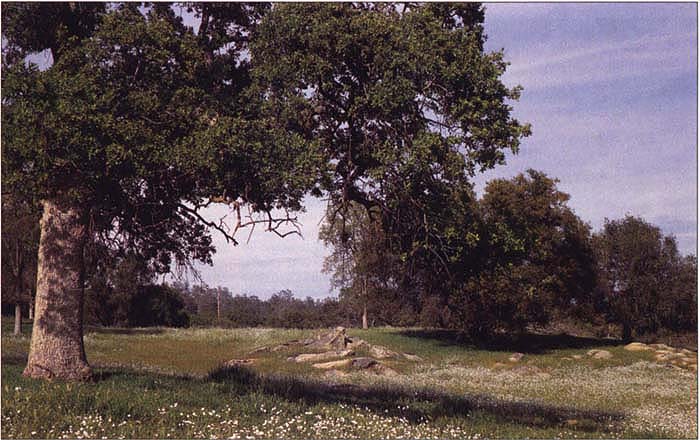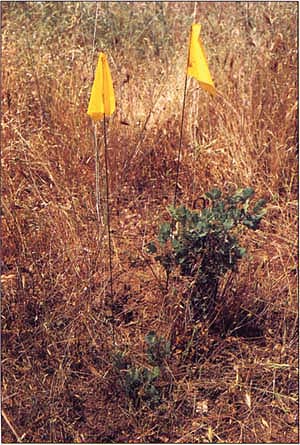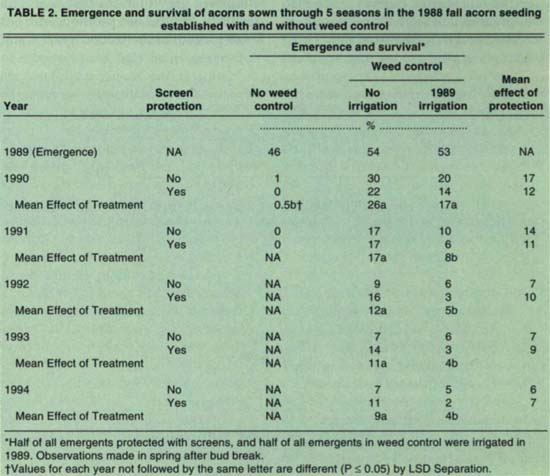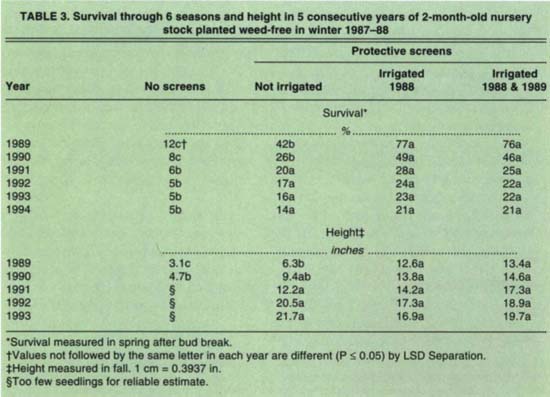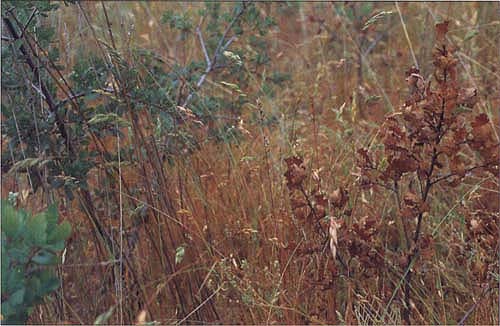All Issues
Planted blue oaks may need help to survive in Southern Sierras
Publication Information
California Agriculture 49(5):13-17. https://doi.org/10.3733/ca.v049n05p13
Published September 01, 1995
PDF | Citation | Permissions
Abstract
Competition from annual herbaceous plants is one of many factors inhibiting establishment of blue oaks in California. Other factors include drought and large and small mammal depredation; gophers are a particularly serious threat to the seedling's emergence and survival. To measure the impact of these and other factors, a series of studies compared the emergence and survival of directly seeded acorns and 2-month-old nursery stock. Results show that careful site selection, control of competition, and protection from mammal predators may all be needed to promote success of restocking programs on California rangelands.
Full text
Many blue oaks in the South Sierra Range region are growing under difficult conditions, including rocky coarse soils.
During the last decade, scientists, resource managers and conservation groups have become increasingly concerned about the lack of young trees in California's native oak stands. Poor establishment varies geographically and within species, but is common in stands of blue oak (Quercus douglasii), the species most widely distributed on the state's rangelands.
Blue oak seedling establishment appears unrelated to regeneration. While research has documented the repeated appearance of abundant numbers of seedlings (defined as plants less than 12 inches high), relatively few plants mature to sapling size, 12 to 60 inches tall or larger. These observations bring into question the ability of blue oak to sustain itself.
We conducted a series of studies to identify the impacts of selected factors on the growth and survival of blue oak seedlings using directly planted acorns and transplanted nursery stock. The studies took place in the South Sierra Hardwood Range region in Madera County. Among the factors we studied were: (1) competition from annual herbaceous plants (seedlings from directly planted acorns); (2) small mammal depredation; and (3) irrigation for seedling establishment. Information is intended to support restoration activities where natural establishment is inadequate.
Annual grass range site
The studies were initiated in 1985 at the San Joaquin Experimental Range, a U.S. Forest Service research facility administered by California State University, Fresno. The area is about 1,000 feet in elevation, and representative of the annual grass range in much of the southern Sierra Nevada foothills. Vegetation consists of open stands of blue oak, scattered interior live oak (Q. wislizenii) and gray or foothill pine (Pinus sabiniana), along with an understory of annual grasses and forbs that grow until all available soil water is exhausted.
Soils present are Ahwahnee and Vista rocky coarse sandy loams with minimal profile development overlying granitic parent material. Two soil families are represented: coarse, loamy, mixed, thermic Mollic Haploxeralfs (Ahwahnee); and coarse, loamy, mixed, thermic Typic Xerochrepts (Vista). These coarse-textured soils vary in depth because of the presence of boulders and bedrock. In areas free of rock outcrops, the root zone is moderately deep (20 to 40 inches) to deep (40 to 60 inches or more), and available soil water ranges from 0.09 to 0.12 inches per inch of depth.
Annual rainfall was below average for most of the study period, with rainfall averaging less than 75% of the 60-year average for five successive growing seasons from 1987 to 1992. During the seven seasons in which data were collected, rainfall ranged from a high of 26 inches in 1992-93 to a low of about 10 inches in 1993-94.
Planted acorns
In late summer and early fall, we collected blue oak acorns representing local ecotypes. We planted the acorns within deer-proof enclosures in late fail (November to December) in 1985, 1987 and 1988. The 1985 planting also included locations outside enclosures. The experimental design was a randomized complete block with four replications. Each replication consisted of 100 acorns planted in four parallel rows. Rows were spaced 1 foot apart, with 25 acorns planted in each row, also 1 foot apart.
Main plot treatments for the first two plantings included chemical weed control and no weed control to measure the effect of competition on oak growth and survival. These treatments were repeated in the 1988 planting, to which we added a third treatment — weed control and irrigation. We used drip irrigation to apply 1 gallon of water weekly to each emerged seedling from mid-June to mid-September, 1989.
Weed control was maintained in the 1987 and 1988 plantings for 3 years, then terminated for several reasons: (1) maintenance of bare soil aggravated erosion, (2) the herbicides had residual effects, which provided adequate control, (3) the reservoir of weed seed in the soil was reduced; and (4) the nature of mortality after 3 years suggested that sustained weed control had become unimportant—rodent depredations were the main problem.
Following emergence, screens were installed to protect seedlings in the 1987 planting from small mammal predation. Half of those in the 1988 planting were also protected, creating a split on main plots. The screens used were 14-strand, rigid plastic seedling protectors 2 inches in diameter and 16 inches high.
Small mammal depredation confounded measurement of emergence in all plantings. Acorns were dug up before and after seedling emergence, before screens could be placed. The 1985 planting was destroyed in this manner and could not be replanted. Ground squirrels (Spermophilus beecheyi) were suspected to be a culprit. Subsequent plantings were made after the local ground squirrel population was reduced, but we used poison bait to maintain squirrel control throughout the study.
Nursery stock
To complement the acorn seeding, 2-month-old nursery stock was planted in winter 1987-88, using the same experimental design with four replications for each treatment. The stock was propagated from acorns collected in 1987. Each replication consisted of 50 transplants divided into four rows, with transplants divided into four rows, with transplants placed 2 feet from neighboring plants. This spacing created a staggered pattern with each row alternating between 12 and 13 transplants. As with the directly seeded acorns, weed control was maintained for 3 years, after which the residual effects of the chemicals provided adequate control. Treatments included: (1) no screen protection, (2) screen protection, and (3) screens plus irrigation with water applied at weekly intervals in the same manner as the acorn trials. For 2 consecutive years, only half of the irrigated treatment in each replication was irrigated during the second growing season.
In winter 1990-91, underground screen protection was put in place to test its efficacy against gophers (Thomomys bottae), a threat both to directly seeded acorns and the nursery stock. The experimental design was used with six replications. Each replication consisted of 50 seedlings propagated from the 1990 collection, half of which were protected by underground tubes of rolled and stapled aluminum screen 2 inches in diameter and 18 inches long. Tubes were placed in holes augered 18 inches deep, which were partially filled with tamped soil, and the seedlings were planted in the last 6 inches of each tube. The planting pattern was the same as that used for the earlier transplant trial, but 10% could not be planted because boulders and bedrock were in the way. After planting, seedlings were protected with aboveground plastic screens and irrigated for the first season. Weed control was maintained for 2 seasons.
Data collected from all trials were evaluated by analysis of variance. Measurements included percentage of emergence; percent survival, measured each year in the spring after bud break; and heights of plants each fall. In measuring height, the longest stem was used if branching occurred. Unless otherwise noted, significant effects were separated by the Least Significant Difference method and reported at the 95% confidence level.
Results for planted acorns
Seedling emergence and survival
Emergence in the 1987 seeding was poor, but was still five times greater in plots with weed control than without it. No seedlings survived longer than 3 seasons without weed control (table 1). Emergence in the 1988 seeding was statistically unaffected by weed control, averaging 50%, but again, seedlings without weed control were dead after 2 seasons (table 2).
Mortality rates were high, even with weed control. In the 1987 seeding, of those that emerged, less than one-third survived beyond the first season; this rate continued to decline to less than 3% of emergence by 1994 (table 1). The 1988 seeding showed similar dramatic mortality rates. The average 1994 survival rate was 12% of emergence.
Aboveground screen protection had no observed beneficial effect, and there was no consistent year-to-year interaction between weed control and screens (table 2). However, the impact of screen protection may have been obscured by damage caused by pocket gophers, which attack from below ground. In the months between April and October 1990, gophers killed 32% of the protected seedlings from the 1988 planting. In contrast, only 19% of the unprotected seedlings were killed by gophers. This difference was significant (P ≤ 0.05). Only dead seedlings with easily identified gopher damage were included in this category. We measured gopher-caused mortality by examining dead plants to determine whether they had been cut below ground.
In weed control treatments, mortality was higher with irrigation and more of this loss was attributed to gophers. Seasonal survival in the irrigated treatment ranged from 60% of the unirrigated treatment in 1990 to 40% in 1994 (table 2). In all years except 1990, this difference was significant (P ≤ 0.05). Over the five growing seasons, mean survival without irrigation was about twice that of the irrigated treatment.
Height
Unirrigated seedlings from the 1988 seeding that were protected were twice as tall as unprotected seedlings, 11 inches compared to 5.5 inches, a significant (P ≤ 0.05) difference. Unprotected seedlings, measured in 1993, showed no difference in height whether irrigated or not. The average height was 6 inches. An inadequate number of plants receiving both irrigation and protection survived to reliably estimate the height for those seedlings.
TABLE 1. Emergence and survival of acorns sown through 4 seasons in the 1987 fall acorn seeding established with and without weed control
TABLE 2. Emergence and survival of acorns sown through 5 seasons in the 1988 fall acorn seeding established with and without weed control
Although screen protection had a significant effect, its value was compromised by the height of the screen. Many protected seedlings were clipped off above the 16-inch screens. The height of the damage and character of the clipped surfaces suggest rabbits (Sylvilagus spp.) were the primary cause of this small mammal predation.
Again, lack of surviving plants prevented a height comparison between treatments in the 1987 seeding. By 1993, however, the average height of the surviving seedlings growing weed-free with protection was 7.5 inches. Photodecomposition of screens after two seasons may have allowed depredation, which restricted seedling height.
Nursery stock survival
After one season, nursery stock that was planted in winter 1987-88 and screened and irrigated survived at nearly twice the rate of stock that was screened but not irrigated. The latter survived at a rate more than three times that of seedlings that received neither treatment (table 3). Irrigating a second season had no influence on survival. In the screened treatments, survival of irrigated plants declined more rapidly during the first three seasons, but there was no difference in survival among screened treatments in the four seasons beginning 1991. After six seasons, average survival for screened plants was four times that of unscreened plants.
TABLE 3. Survival through 8 seasons and height in 5 consecutive years of 2-month-old nursary stock planted weed-free in winter 1987-88
Gophers were responsible for nearly 60% of the losses in the two irrigated treatments, again suggesting irrigation may have encouraged gopher depredation. Underground screens installed in the 1990-91 season appeared to provide some protection, with nearly 90% of protected seedlings still alive in spring 1994. By contrast, less than half of unprotected seedlings were still alive. This was a highly significant (P ≤ 0.01) difference.
In the 1987-88 trial, screened plants showed no significant differences in height after 1989, when height was first measured (table 3). Irrigation stimulated growth in the first year (P ≤ 0.05), but did not promote additional growth in the second year. The apparent unsustained differential in growth after irrigation ceased may represent the combined effects of rabbit depredation and discontinuing irrigation. Too few unscreened, unirrigated seedlings survived to provide a current estimate of height. However, when last measured in 1990, height was 33% of screened and irrigated treatments (P ≤ 0.05). At that time, the data from the few surviving plants were too variable to analyze differences in which the presence or absence of screens was the only factor.
Weeds, rodents hinder seedlings
Abundant evidence exists throughout North America that control of herbaceous vegetation benefits the survival and growth of oaks and other hardwoods, whether propagated naturally or artificially. This finding is supported by our studies and others using blue or valley oak (Q. lobata). Other investigations have found that a decline in rainfall, combined with annual grass competition, greatly reduced blue and valley oak seedling establishment.
The value of aboveground protection against rodent depredation found in our trials has also been demonstrated in other hardwood studies. A study conducted at the UC Hopland Research and Extension Center (HREC) in Mendocino County from 1989 to 1994 found that blue oak seedlings, protected by aboveground screens and weed control, survived at twice the rate of unprotected seedlings, and were three times as tall. Protected blue oak nursery stock planted in winter 1987-88 and growing weedfree at the UC Sierra Foothill Research and Extension Center in Yuba County also survived in double the numbers of unprotected plants, and were 70% taller than unprotected seedlings. In a similar planting of blue oak nursery stock at HREC, survival with protection was nearly 10 times that of unprotected seedlings.
Using underground screens to protect against gophers has also been studied on valley oak in San Luis Obispo County, using methods similar to those in our study without any adverse effects on plant growth. As the seedling grows, its expanding root mass puts pressure on the slowly oxidizing screen tubes, causing the screen tubes to open along the seams, allowing unrestricted growth.
The underground screens we used may have been longer than needed. Most gopher foraging burrows are found at a depth of 6 to 8 inches, so underground screens shorter than 12 inches might provide adequate protection.
In the 1988-89 trial, planted acorns that were protected only by aboveground screens suffered higher gopher depredation as compared to acorns not screened. This was similar to the mortality seen in the valley oak study. We speculate that the rodents somehow distinguish between the two groups of seedlings; the greater vigor and root reserves of protected seedlings may make them more attractive to gophers.
While other researchers have obtained higher oak seedling survival with supplemental water in Tuolumne County, irrigation did not improve survival in our plots. In our study, irrigation in a naturally dry setting appeared to attract gophers, contributing to differential mortality in the 1988 acorn seeding and accelerated mortality, initially, for nursery stock planted in 1987-88. Applying water apparently improved burrowing conditions, giving the gophers easier access to seedling roots. Water also may have produced healthier seedlings that were more attractive to rodents.
The concentration of planted acorns and nursery stock in this study also may have contributed to attack by rodents. Wildlife biologists have determined that gophers use the sense of smell and other senses to locate food. Thus, seedlings planted in closely spaced geometric patterns may be more vulnerable to predation than those approximating the more random natural distribution of oak trees.
Although rodent depredation influenced survival, the effect of a succession of drought years cannot be ignored. The average annual rainfall was only 65% of the long-term average during the first two growing seasons for the 1987 and 1988 seedings. We suspect low rainfall aggravated an already stressful situation created by droughty soil.
Conclusions
Competing herbaceous vegetation can severely limit the emergence of oak seedlings from planted acorns and, more importantly, may prevent the development of seedlings into saplings. Weed control, practiced for two or more seasons, may be necessary to successfully maintain and restore blue oak stands in California.
Weed competition is only one of several obstacles to oak establishment. Site selection must also be considered. Restoration projects should be undertaken on sites where the species naturally occurs. Boulders and other conditions below the surface may restrict seedling growth. Careful review of appropriate soil surveys is necessary before initiating planting activities.
Preventing large and small mammal depredation is as critical as herbaceous control. Herbivory may vary with time and place, but some level of protection will almost always be needed until oak trees are big enough to resist attack. Experience suggests that gophers present the longest threat: oak roots can remain vulnerable to attack until trees are 2 or more inches in diameter at the soil surface.
The type of aboveground protection that is most effective will depend on the nature of the threat. The coarse plastic screens used in this study were adequate to protect against small rodents. However, protection against insects and even smaller rodents, such as meadow voles (Microtus spp.) and deer mice (Peromyscus maniculatus), requires a finer mesh. A fine mesh defense, such as window screen cages, has been used successfully to exclude grasshoppers (Melanoplus devastator).
Survival of screened, unirrigated 1987-88 nursery stock was about 25% greater than that of similarly treated seedlings developed from directly planted acorns. However, costs of propagating, transporting and planting this nursery stock make it economically unattractive on rangelands, a conclusion reached by others in the Tuolumne County study.



